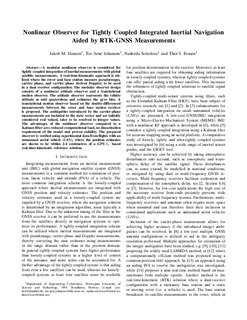| dc.contributor.author | Hansen, Jakob Mahler | |
| dc.contributor.author | Johansen, Tor Arne | |
| dc.contributor.author | Sokolova, Nadezda | |
| dc.contributor.author | Fossen, Thor I. | |
| dc.date.accessioned | 2019-12-02T09:10:31Z | |
| dc.date.available | 2019-12-02T09:10:31Z | |
| dc.date.created | 2019-03-12T18:16:10Z | |
| dc.date.issued | 2018 | |
| dc.identifier.citation | IEEE Transactions on Control Systems Technology. 2018, 1-6. | nb_NO |
| dc.identifier.issn | 1063-6536 | |
| dc.identifier.uri | http://hdl.handle.net/11250/2631200 | |
| dc.description.abstract | A modular nonlinear observer is considered for tightly coupled integration of inertial measurements with global satellite measurements. A real-time-kinematic (RTK) approach is utilized where the rover and base station measure pseudoranges, carrier-phase, and carrier-phase derived Doppler, to be used in a dual receiver configuration. The modular observer design consists of a nonlinear attitude observer and a translational motion observer (TMO). The attitude observer represents the vehicle attitude as unit quaternions and estimates the gyro bias. A TMO based on the double-differenced measurements between the rover and base station receiver is proposed. The ambiguities introduced by the carrier-phase measurements are included in the state vector and are initially considered real valued, later to be resolved to integer values. The advantages of the nonlinear observer compared with a Kalman filter are reduced computational load, no linearization requirement of the model, and proven stability. The proposed observer is verified using experimental data from flights with an unmanned aerial vehicle, where the position estimates are shown to be within 2-4 cm of a global positioning system L 1 -based RTK reference solution. | nb_NO |
| dc.language.iso | eng | nb_NO |
| dc.publisher | Institute of Electrical and Electronics Engineers (IEEE) | nb_NO |
| dc.title | Nonlinear Observer for Tightly Coupled Integrated Inertial Navigation Aided by RTK-GNSS Measurements | nb_NO |
| dc.type | Journal article | nb_NO |
| dc.type | Peer reviewed | nb_NO |
| dc.description.version | acceptedVersion | nb_NO |
| dc.source.pagenumber | 1-6 | nb_NO |
| dc.source.journal | IEEE Transactions on Control Systems Technology | nb_NO |
| dc.identifier.doi | 10.1109/TCST.2017.2785840 | |
| dc.identifier.cristin | 1684287 | |
| dc.relation.project | Norges forskningsråd: 221666 | nb_NO |
| dc.relation.project | Norges forskningsråd: 223254 | nb_NO |
| dc.description.localcode | © 2019 IEEE. Personal use of this material is permitted. Permission from IEEE must be obtained for all other uses, in any current or future media, including reprinting/republishing this material for advertising or promotional purposes, creating new collective works, for resale or redistribution to servers or lists, or reuse of any copyrighted component of this work in other works. | nb_NO |
| cristin.unitcode | 194,63,25,0 | |
| cristin.unitname | Institutt for teknisk kybernetikk | |
| cristin.ispublished | true | |
| cristin.fulltext | original | |
| cristin.fulltext | postprint | |
| cristin.qualitycode | 2 | |
